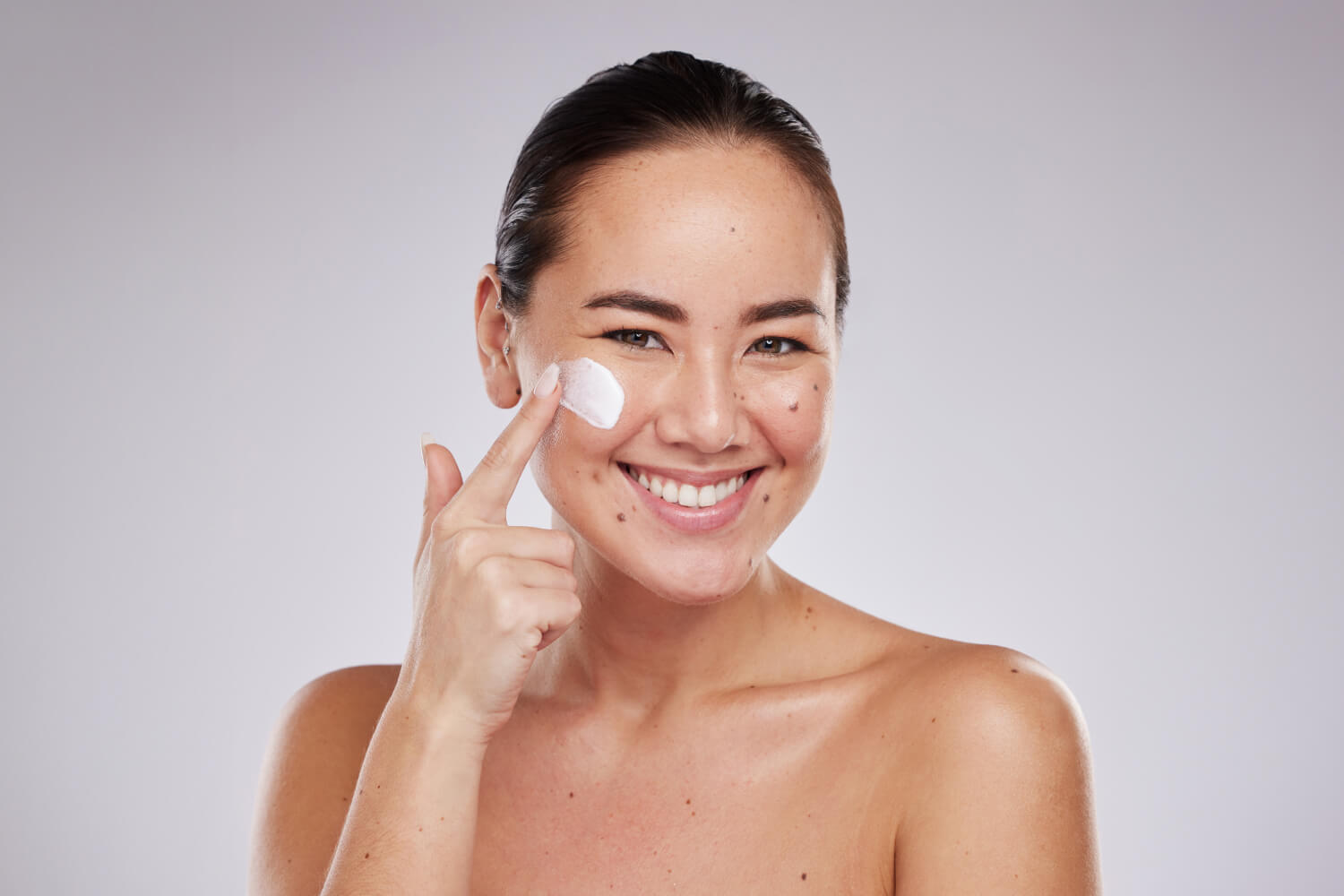
If you’re the kind of person who wears sunscreen on the daily, you know how challenging it can be to select a sunscreen that suits your every preference. From sun protection ratings (SPF and beyond) to ingredients, from textures to finishes, there’s a lot to consider–so how do you actually choose the right face sunscreen?
In this post, we’ll walk you through the features and characteristics to consider when selecting a sunscreen: from the most technical, like protection ratings, to the most cosmetic, like texture and finish. There’s a plenty of options out there, and we’re sure one of them will be perfect for you!
On this post:
Do you need a specific sunscreen for your face?
Before we begin, let’s take a step back and ask ourselves a philosophical question: do we actually need a specific sunscreen for our face? Yes, we probably do, but it’s worth looking into what that means. From a sunscreen safety perspective, there’s no reason why you can’t use body sunscreen on your face. Cosmetically, though, it may not be the best option.
Body sunscreens tend to feature hydrating formulas with a bit of a shine to them, which may not be a great fit for those with combination or oily sunscreen, who tend to prefer a sunscreen with a more mattifying finish. There is another cosmetic issue to consider, which is the fact that body sunscreens are not formulated to be used with other products, so they may not play well with the rest of your skincare routine. Indeed, you may experience more pilling when trying to apply body sunscreen over your facial skincare products, or when applying makeup over your body sunscreen.
Finally, there is a comfort issue to consider: what happens if your sunscreen gets into your eyes? Facial sunscreens are formulated with the knowledge that the product will be applied near your eyes and may occasionally come into contact with them–it happens a lot when you sweat and the sunscreen migrates a bit–, so efforts are made to reduce stinging or burning. Body sunscreens do not necessarily take this into account, so they can cause intense burning if (or when) they get into your eyes.
What to look for in facial sunscreen
Now that we’ve discussed the differences between sunscreen that’s formulated for your face vs your body, let’s go over the main features to keep in mind when shopping for a facial sunscreen:
SPF: For UVB protection
When trying to figure out how “protective” your sunscreen is, you’ll probably be looking at the SPF rating. SPF means “Sun Protection Factor”, and it measures the amount of protection that a sunscreen offers against UVB radiation–which is the type of radiation responsible for burning your skin. Here’s what some common SPF values mean:
- SPF15: protects from 93% of UVB radiation;
- SPF30: protects from 97% of UVB radiation;
- SPF50: protects from 98% of UVB radiation.
Depending on where you are in the world, you may also find sunscreens labeled with higher ratings, such as SPF60 or SPF100, but this isn’t common everywhere. In Europe, for instance–which is where we, Care to Beauty, are located–, brands are not legally allowed to label a product with a value over SPF50. Should their product protect against more than 98% of UVB radiation, it’ll be labeled SPF50+.
There’s a good reason for this, and it has to do with how consumers interpret the number 100 in combination with SPF ratings. If you see a sunscreen labeled SPF100, you might think it’s protecting you from 100% of UVB radiation–but that’s not true, nor is it actually possible for a sunscreen.
Likewise, you may think that SPF100 offers double the protection of SPF50, but that’s not true either. Think about it: you’d think SPF30 would be twice as protective as SPF15, but the actual difference between the two is only 4%. Between SPF30 and SPF50, it’s only 1%. The difference between SPF50 and SPF100 is even smaller, and it gets smaller the further up you go: the higher the SPF rating, the smaller the gains between different ratings.
Knowing this, you see how labeling a product with SPF100 may mislead consumers into thinking the product offers 100% protection, or twice the protection of SPF 50, which is not true. The European solution? Over SPF50, everything gets labeled with SPF50+.
| Our Recommendation |
|---|
| To maximize UVB protection, choose a sunscreen with SPF50 or SPF50+ |
Broad-spectrum: For UVA protection
We’ve already explored SPF, which is the amount of protection a sunscreen offers against UVB radiation, but that’s not the whole story. Sunlight is made up of many different types of radiation, and there is another type to watch out for, and that’s UVA. Unlike UVB rays, which are more often associated with sunburn, UVA rays penetrate deeper into the skin and are more often associated with tanning, dark spots, and photoaging.
If you want a sunscreen that protects you against both UVB and UVA rays, you’ve got to look for “broad-spectrum” sunscreen. It shouldn’t be too hard. Broad spectrum is pretty much the norm these days, so you can simply look for those words on the label to check whether your chosen sunscreen offers an adequate amount of UVA protection.
And just in case you’d like to know the level of UVA protection that a sunscreen offers, just like you know the level of UVB protection through the SPF rating, there are ratings for that too:

- The Japanese system uses the letters “PA” followed by plus signs to indicate how much UVA protection a product offers. You should be looking for products rated PA+++, high UVA protection, or PA++++, extremely high UVA protection;
- The European Union recommends that the UVA protection of each sunscreen be at least one third of the SPF indicated on the label. That means that a product with SPF30 should have a UVA protection rating, or PPD, of 10. A product that meets this requirement will be labeled with a UVA logo that features the letters “UVA” printed inside a circle.
| Our Recommendation |
|---|
| To maximize UVA protection, choose a sunscreen with the letters “UVA” printed inside a circle, or look for a high PA rating |
Sunscreen ingredients: Mineral vs chemical
In terms of the ingredients they use to offer sun protection to your skin, sunscreens can be “mineral” or “chemical”. “Mineral” sunscreens are also called inorganic or physical sunscreens; “Chemical” sunscreens are also called organic sunscreens. So, what’s the difference?
If a sunscreen provides sun protection through the action of zinc oxide or titanium dioxide, without any extra sun filters, it’s a “mineral” sunscreen. If a sunscreen uses any other sun filter–and you may have heard of a few, such as Mexoryl, Tinosorb, Uvinul, and so on–, it’s a “chemical” sunscreen.
Back in the day, we believed that mineral sunscreens deflected–or “reflected–radiation and that chemical sunscreens absorbed it. Science has marched on, and we now understand that both mineral and chemical sunscreens offer protection by deflecting and absorbing radiation. As far as protective mechanisms go, your skin is similarly protected by both mineral and chemical sunscreens.
That being said, they do have their pros and cons. Mineral sunscreens can be a little thicker and tackier in texture, due to the physical characteristics of zinc oxide and titanium dioxide, and they often leave a white or gray finish on the skin, which comes from the white color of these compounds. This dreaded “white cast” can be improved by using sunscreens with “nano” versions of zinc oxide and titanium dioxide, but it’s never fully eliminated. This is, of course, particularly problematic on dark skin tones. Among its advantages, mineral sunscreen is generally very well-tolerated by sensitive skin; indeed, it’s often recommended for children under 3 years old.
Chemical sunscreens avoid many of the cosmetic shortcomings of mineral sunscreen–they are more fluid, more pleasant to apply and spread on the skin, and they avoid the issue of the white cast. However, not all skin types tolerate all chemical sunscreens. That’s to be expected, of course, as there is a huge range of sun filters and sun filter combinations out there, and some are better suited to some skin types than others.
| Our Recommendation |
|---|
| Mineral and chemical sunscreens are both safe and effective, so feel free to choose based on personal preference.
If you have darker skin, you may prefer chemical sunscreens to avoid the dreaded “white cast”; if you have very sensitive skin, you may prefer mineral sunscreens to avoid any reactivity. It’s up to you! |
Texture
Your skin type may influence your choice of texture.
We usually recommend that you go for a cream or an emulsion/lotion/gel cream. Usually, people with oily skin tend to prefer lighter versions, such as oil-free emulsions or gels. If you have dry skin, you will probably prefer heavier formulas such as creams, that nourish your skin for longer.
Texture isn’t only important to match your skin type, though: it’s also important because it’s going to help achieve your desired level of protection. Fluid textures are easily spreadable and that is not necessarily a good thing in sunscreens. More spreadability means you will need less product to cover the entire surface of the skin. Which, in turn, means that you’ll use less sunscreen than you should. One other issue is related to pigmented and powder products. You will never apply the right amount of sunscreen because you’d look like a Madame Tussaud’s figurine–or Marie Antoinette, all covered in powder! Additionally, spray sunscreens are great but save them for reapplying your sunscreen throughout the day.
| Our Recommendation |
|---|
| To ensure adequate sun protection, opt for the most “consistent” sunscreen texture you can tolerate. For dry skin, try a cream; for oily skin, a gel-cream can be a good choice.
Fluid textures feel amazing on the skin, but you need to be diligent about the amount of product you apply. When in doubt, add some more! |
Finish: Tinted vs untinted
Some formulas have tinted options, so if you’re looking for a bit of color correction, this option might help you combine two products in one.
However, keep in mind that tinted sunscreens might make you use less of them due to wanting to have light coverage. Always keep in mind that the amount of product should always be around 1 teaspoon for the face, neck, and head. In spite of this recommendation, what you should always keep in mind is that you should properly cover the entirety of your skin, and that varies with several factors such as if you have a beard and how large your face is.
| Our Recommendation |
|---|
| If you want some color correction to go along with your sunscreen, a tinted formula may be a good choice. Just make sure you apply the right amount of product! |
Beauty Writer & Editor


